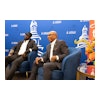The vote on February 10, 2015 by the South Carolina House Ways and Means Subcommittee on Higher Education to recommend the two-year closure of South Carolina State University (SCSU)—the state’s only public Black institution and an 1890 land-grant university—on July 1, 2015 has sent concern throughout the HBCU community.
 John Michael Lee, Jr.
John Michael Lee, Jr.
Many HBCU proponents have expressed their shock and disbelief that this drastic action could even be considered by the state of South Carolina. Supporters of the measure point to the history of the lack of transparency, fiscal management, leadership and oversight at the institution. It is true that, in the past, S.C. State has suffered from poor oversight by a dysfunctional board of trustees, instability in leadership and problems with fiscal management. These issues have landed the university on probation with its accrediting body, the Southern Association of Colleges and Schools.
An article in The State also reported on the four-year graduation rate of 14 percent for South Carolina State University and mentioned the institution’s declining enrollment. I would like to provide some perspective on that number.
According to the U.S. Department of Education’s 2013 Digest of Educational Statistics, the national 4-year and 6-year graduation rate for African-Americans at public 4-year universities is 17 percent and 36 percent, respectively. While omitted from the article, South Carolina State’s 6-year graduation rate is 36 percent; thus, the institution performs around the national average given its type and student population. It is also true the university has experienced sharp declines in enrollment though much of that decline was due to the harmful changes made to the Federal Parent-Plus Loan Program in 2012.
However, what is disturbing is the historic nature of the argument that is being put forth by the South Carolina legislature.
S.C. State not only suffers from the problems above, but also is plagued by the historic, current and persistent underfunding from the same legislature that is charged with providing fair and equitable funding. For example, S.C. State receives money from the federal government to carry out its land-grant mission through agricultural research and extension activities throughout the state. This funding received from the U.S. Department of Agriculture as a part of the Farm Bill also requires each state to provide matching funds to each university in the state that receives land-grant funding.
A 2013 publication by the Association of Public and Land-grant Universities, Land-grant but Unequal: State One-to-One Match Funding for 1890 Land-grant University, shows that, while the South Carolina legislature provides this funding to Clemson University—the state’s other land-grant institution—it does not provide this funding to S.C. State. In fact, the report shows that, from 2010 to 2012, S.C. State was underfunded by $6,029,090. This is just one measurable example of the state’s failure to provide S.C. State with the adequate resources necessary to operate, yet there are several more that could be used to illustrate this point.
Contrary to popular belief, S.C. State alumni are meeting the challenge to help and have opened up their wallets to support the university above and beyond their means. Many of their chapters of its national alumni association across the country have been active in recruiting students and providing scholarships to help needy students stay in school. Many alumni have also been active in advocating for change at S.C. State and want the institution to have the resources and leadership it deserves to be successful. While the university community has rallied to the institution’s aid, these contributions will mean little without the support from the state legislature to ensure the same.
In the 20 months (less than two years) since Dr. Thomas Elzey took over as S.C. State’s president, he has worked tirelessly to address the problems at the institution head on by instituting transparency, financial controls and fiscal management. However, it will take time—and the unwavering support of the legislature and governor—for Elzey and his team to successfully implement the long-term strategy necessary to clean up the mess that he inherited. Like President Obama, Elzey is the fix-it man.
As the story continues to unfold, the spotlight is now on the state of South Carolina, and the nation is watching. The battleground for the continued existence of public HBCUs has momentarily moved away from Louisiana, Mississippi and Georgia—all states where politicians have recently suggested or are planning the closure or merger of public HBCUs. Instead, it has shifted to the meeting rooms of the South Carolina legislature.
There is no doubt that, If South Carolina finds a way to maneuver the closure of the state’s only public HBCU, other states will soon follow suit. Thus, all HBCU proponents must stand collectively in support of S.C. State. Together, they must urge South Carolina Governor Nikki Haley and the state legislature to commit to adequate, fair and equitable funding for South Carolina State University.
John Michael Lee, Jr., Ph.D. is the president of North Star Educational Consulting, and he recently served as the Vice President for the Office for Access and Success at the Association of Public and Land-grant Universities. Lee is a graduate of Florida A&M University.



















